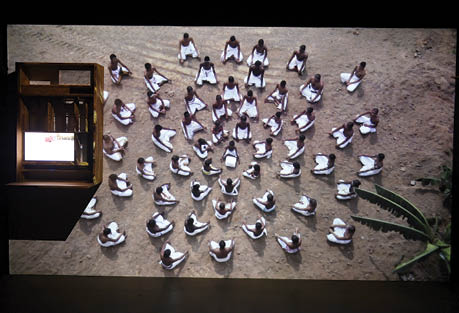Astha Butail’s new exhibition includes installation pieces, sculptures, videos and audio clips that collectively make a statement about the cultural importance of the world’s oral traditions, which the artist has extensively researched, writes Bhumika Popli.
Astha Butail’s year-long engagement with oral traditions of the world has resulted in a solo exhibition, In The Absence Of Writing, now on view at 24, Jor Bagh—a Delhi venue of the Gujral Foundation. The show includes videos, audio clips, photographs, sculptures and installations pieces by the artist.
Butail’s artworks are quite interactive. The first installation we see upon entering the premises is called And Secrets Are Secrets. It is the size of a huge wall, is made using slate stone, wooden slabs and handmade notebooks, and looks like a large open scroll. A short note placed on this artwork invites viewers “to write, draw or doodle your self-portrait”. According to the curator of the show, Reha Sodhi, “The artist is trying to imply that nobody knows when the oral traditions originated and such traditions were always present in the people. With this thought the artist has invited viewers to make a self-portrait furthering the idea of what constitutes a human body.”

Sodhi also draws our attention to the elements of nature that Butail has incorporated in her work. She says, “Earth comes into the exhibition space through the mud wall, fire through the work at the rooftop which displays the reflection of fire, water comes into play through thin copper pipes running across the venue and the sense of smell is represented using a video work where the artist is talking about one oldest tree.”
All the exhibits included in the show are products of Butail’s extensive research of canonical texts. Her research focused on the Hindu Rigveda, the Zoroastrian Avesta and the Jewish Oral Torah. Centuries ago, these ancients texts were circulated among people by word of mouth. “I wanted to explore what the people of other countries were doing with their oral traditions and I found resonance in Zoroastrian Avesta and Jewish Oral Torah. I also found out that religion by itself in India was only coined in the late 18th century. It comes from a Latin word religiō, which means ‘to repeat itself’. The Rigveda is all about the repetition of hymns. Repetition is religion. It got wrongly interpreted through whatever body and that became really problematic,” says Butail.

The artist became interested in the subject of Vedic literature because as a child she found many discrepancies in what she was told about religion and the Vedas. “As a child, I was fascinated by Sanskrit. And while growing up I was reading mythological books. I was trying to understand where we all have come from. There was a lot of contradiction here. Also, there was no clarity on deities. One deity was called something else in one part of the country and in another part, the same deity was known by another name. Digging deeper, I found that everything was connected to the Rigveda, the oral tradition of India, and that’s how my research started.”
Butail’s research took her to Iran, Israel, London and within India, she found herself in Varanasi and certain towns of South India. She interacted with a number of scholars and practitioners of these ancient traditions. In one of her videos, entitled Of A Flux Of Hopes, the artist is seen trying to fix a white-coloured tent on the ground. She took this tent everywhere she went. In the video, we also see people in white clothes, possibly the community leaders from different religious traditions, walking towards the tents at the invitation of the artist. We also find this tent at the Delhi show, as an installation called There Is Enough Room For Everyone.

Sound is the main medium of the installation entitled Stir A Miracle, which is based on Butail’s thesis that vowels are at the centre of the oral traditions of the world. In its first section, we hear vowel sounds which have been collated after being edited out of diverse recordings of chants and hymns across various cultures. According to the curator, “Butail comments on affinities that exist between different cultures as knowledge systems passed on orally.”
In the remaining two sections of the same sound installation, we hear the sounds of children, crying and laughing by alternately. Butail says, “Children cry and laugh in vowels which sound the same throughout the world. If you minutely observe, the first sounds of a child are actually vowels. We don’t teach them this but vowels are actually the first sounds which we hear from a child.”
Her research into the Vedic traditions enabled Butail to experience India’s pre-colonial cultures. “Colonisation disrupted many things and one of those were scientifically proven methods of living a good life,” says Butail. According to her research, the idea of Sunday was never present in India. Instead, people used to take a break from work on a no-moon day. She says, “I follow this ritual and it has energised me to a large extent.”
She was supported in her research by BMW’s Art Journey award, which she won for the years 2017-18.
‘In the Absence of Writing’ is on view till 28 February at 24 Jor Bagh

